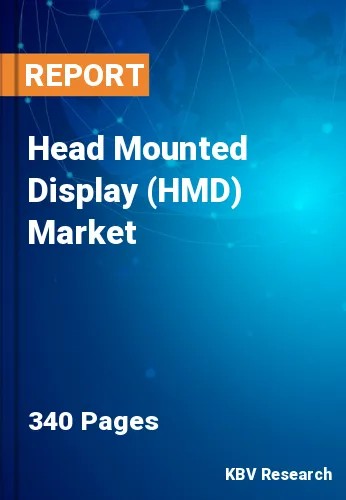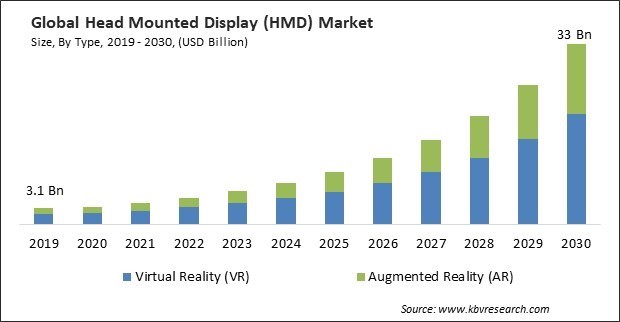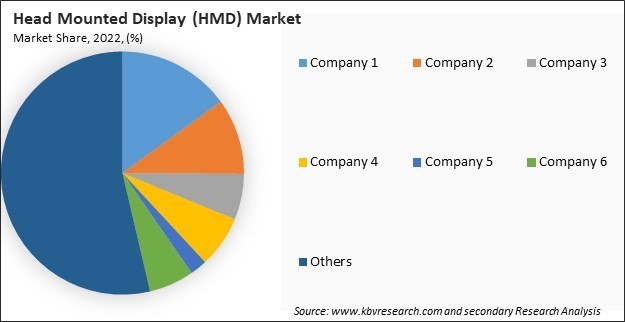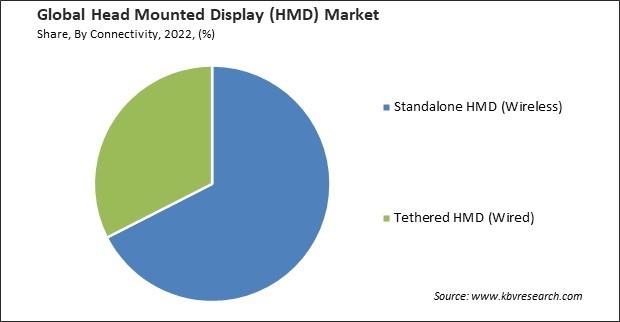
The Global Head Mounted Display (HMD) Market size is expected to reach $33.0 billion by 2030, rising at a market growth of 27.3% CAGR during the forecast period.
HMDs contribute to patient care by offering innovative solutions for treatment and rehabilitation. Therefore, the healthcare segment captured $388.0 million revenue in the market in 2022. Virtual reality therapy, for example, is used for pain management, anxiety reduction, and distraction during medical procedures. HMDs enable a three-dimensional, more immersive representation of medical imaging data, including CT and MRI scans. As a result, these factors are expected to boost the demand in the segment. Some of the factors impacting the market are continuous evolution of display technologies, evolving consumer preferences for immersive experiences, and high cost of head mounted display devices.

Higher resolution displays in HMDs result in sharper and more detailed visuals. This improvement is particularly crucial for applications such as gaming, virtual reality (VR), and augmented reality (AR), where users demand heightened immersion. With displays that render fine details, users can experience more realistic and engaging virtual environments. A wider field of view in HMDs allows users to perceive a more extensive portion of their virtual or augmented surroundings. This contributes to a more natural and immersive experience, reducing the likelihood of users feeling constrained or disconnected from the digital environment. Additionally, consumers are increasingly drawn to immersive experiences beyond traditional screen-based gameplay in the gaming industry. Using head-mounted displays (HMDs) adds a revolutionary new level to gaming, enabling players to become completely submerged in virtual worlds. The demand for HMDs is fueled by the desire for a more realistic, interactive, and captivating gaming experience. Features such as high-resolution displays, responsive head tracking, and realistic spatial audio contribute to a sense of presence that traditional gaming setups cannot match. These factors will increase demand in the market.
However, high-quality HMDs often have advanced features, superior display technologies, and cutting-edge functionalities. However, these devices' premium components and technologies increase production costs, increasing retail prices. Consequently, a significant portion of the consumer market may find these devices financially out of reach, limiting their adoption to a more affluent demographic. The high cost creates a segment in the consumer market where only a subset of consumers with higher disposable incomes can purchase high-quality HMDs. This segmentation may hinder the widespread integration of HMDs into mainstream consumer culture, limiting their reach and impact on a broader scale. Thus, these factors will limit the growth of the market.

The leading players in the market are competing with diverse innovative offerings to remain competitive in the market. The above illustration shows the percentage of revenue shared by some of the leading companies in the market. The leading players of the market are adopting various strategies in order to cater demand coming from the different industries. The key developmental strategies in the market are Acquisitions, and Partnerships & Collaborations.
On the basis of technology, the market is divided into augmented reality (AR) and virtual reality (VR). The augmented reality (AR) segment recorded a substantial revenue share in the market in 2022. Industries have embraced AR HMDs for various industrial applications, including assembly line processes, equipment maintenance, and quality control. Workers can benefit from real-time data, instructions, and visualizations superimposed onto their field of view, leading to increased productivity and reduced error rates. These factors will boost the demand in the segment.
On the basis of connectivity, the market is divided into tethered HMD (wired) and standalone HMD (wireless). The standalone HMD (wireless) segment recorded the maximum revenue share in the market in 2022. Wireless connectivity contributes to a more seamless and immersive user experience. Users can interact with virtual environments without the restrictions imposed by cables, leading to a more natural and engaging experience in applications such as gaming, virtual tours, and simulations. These aspects will lead to rapid expansion of the segment.

Based on component, the market is divided into processors & memories, displays, lenses, sensors, controllers, cameras, and others. The sensors segment procured a promising growth rate in the market in 2022. Sensors like accelerometers, gyroscopes, and magnetometers enable HMDs to track the user's head movements accurately. This enhances the user's ability to interact with virtual or augmented content naturally and intuitively, creating a more immersive experience. As a result, there will be increased demand in the segment.
Based on application, the market is divided into consumer, aerospace & defense, healthcare, enterprise, commercial, automotive, energy, and others. The consumer segment recorded the maximum revenue share in the market in 2022. The introduction of more affordable and user-friendly HMDs has widened consumer demand. Companies have developed standalone VR headsets and mixed-reality devices that balance performance and affordability, making them accessible to a broader audience. These factors will drive the segment’s expansion in the future.
| Report Attribute | Details |
|---|---|
| Market size value in 2022 | USD 4.9 Billion |
| Market size forecast in 2030 | USD 33 Billion |
| Base Year | 2022 |
| Historical Period | 2019 to 2021 |
| Forecast Period | 2023 to 2030 |
| Revenue Growth Rate | CAGR of 27.3% from 2023 to 2030 |
| Number of Pages | 340 |
| Number of Table | 510 |
| Report coverage | Market Trends, Revenue Estimation and Forecast, Segmentation Analysis, Regional and Country Breakdown, Market Share Analysis, Porter’s 5 Forces Analysis, Company Profiling, Companies Strategic Developments, SWOT Analysis, Winning Imperatives |
| Segments covered | Component, Technology, Connectivity, Application, Region |
| Country scope |
|
| Companies Included | Meta Platforms, Inc. (Meta), Sony Corporation, Microsoft Corporation, Samsung Electronics Co., Ltd. (Samsung Group), Magic Leap, Inc., Google LLC (Alphabet Inc.), DPVR, Seiko Epson Corporation, HTC Corporation, and Vuzix Corporation |
| Growth Drivers |
|
| Restraints |
|
By region, the market is segmented into North America, Europe, Asia Pacific, and LAMEA. In 2022, the North America segment acquired the highest revenue share in the market. Adopting HMDs in enterprise and industrial applications, such as manufacturing, healthcare, and education, contributes to market growth. Industries in North America often prioritize technological advancements, and integrating HMDs in these sectors can boost the demand. Therefore, the segment will grow rapidly in the upcoming years.
Free Valuable Insights: Global Head Mounted Display (HMD) Market size to reach USD 33 Billion by 2030
The market research report covers the analysis of key stake holders of the market. Key companies profiled in the report include Meta Platforms, Inc. (Meta), Sony Corporation, Microsoft Corporation, Samsung Electronics Co., Ltd. (Samsung Group), Magic Leap, Inc., Google LLC (Alphabet Inc.), DPVR, Seiko Epson Corporation, HTC Corporation, and Vuzix Corporation
By Technology
By Connectivity
By Component
By Application
By Geography
The Market size is projected to reach USD $33.0 billion by 2030.
Continuous evolution of display technologies are driving the Market in coming years, however, High cost of head mounted display devices restraints the growth of the Market.
Meta Platforms, Inc. (Meta), Sony Corporation, Microsoft Corporation, Samsung Electronics Co., Ltd. (Samsung Group), Magic Leap, Inc., Google LLC (Alphabet Inc.), DPVR, Seiko Epson Corporation, HTC Corporation, and Vuzix Corporation
The expected CAGR of this Market is 27.3% from 2023 to 2030.
The Virtual Reality (VR) segment is registering maximum revenue in the Global Head Mounted Display (HMD) Market by Technology in 2022; thereby achieving a market value of $20.1 billion by 2030.
The North America region dominated the Market by Region in 2022, and would continue to be a dominant market till 2030; thereby, achieving a market value of $10.6 billion by 2030.
Our team of dedicated experts can provide you with attractive expansion opportunities for your business.
